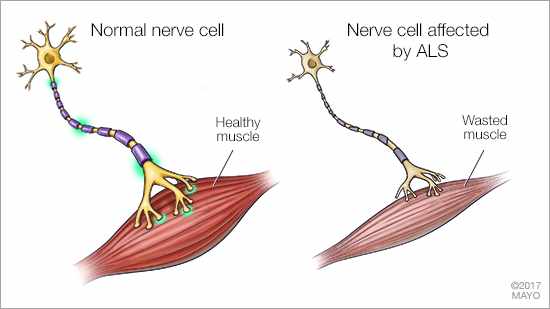-
Learn more about amyotrophic lateral sclerosis, or ALS
Amyotrophic lateral sclerosis (a-my-o-TROE-fik LAT-ur-ul skluh-ROE-sis), or ALS, is a progressive nervous system (neurological) disease that destroys nerve cells and causes disability.
ALS is often called Lou Gehrig's disease, after the famous baseball player who was diagnosed with it. ALS is a type of motor neuron disease in which nerve cells gradually break down and die.
Doctors usually don't know why ALS occurs. Some cases are inherited.
ALS often begins with muscle twitching and weakness in a limb, or slurred speech. Eventually, ALS affects control of the muscles needed to move, speak, eat and breathe. There is no cure for ALS, and eventually the disease is fatal.
Symptoms
Early signs and symptoms of ALS include:
- Difficulty walking or doing your normal daily activities
- Tripping and falling
- Weakness in your leg, feet or ankles
- Hand weakness or clumsiness
- Slurred speech or trouble swallowing
- Muscle cramps and twitching in your arms, shoulders and tongue
- Difficulty holding your head up or keeping good posture
ALS often starts in the hands, feet or limbs, and then spreads to other parts of your body. As the disease advances and nerve cells are destroyed, your muscles progressively weaken. This eventually affects chewing, swallowing, speaking and breathing.
ALS doesn't usually affect your bowel or bladder control, your senses or your thinking ability. It's possible to remain actively involved with your family and friends.
Causes
ALS is inherited in 5 to 10 percent of cases, while the rest have no known cause.
Researchers are studying several possible causes of ALS, including:
- Gene mutation. Various genetic mutations can lead to inherited ALS, which causes nearly the same symptoms as the noninherited form.
- Chemical imbalance. People with ALS generally have higher than normal levels of glutamate, a chemical messenger in the brain, around the nerve cells in their spinal fluid. Too much glutamate is known to be toxic to some nerve cells.
- Disorganized immune response. Sometimes a person's immune system begins attacking some of his or her body's own normal cells, which may lead to the death of nerve cells.
- Protein mishandling. Mishandled proteins within the nerve cells may lead to a gradual accumulation of abnormal forms of these proteins in the cells, destroying the nerve cells.
Risk factors
Established risk factors for ALS include:
- Heredity. Five to 10 percent of the people with ALS inherited it (familial ALS). In most people with familial ALS, their children have a 50-50 chance of developing the disease.
- Age. ALS risk increases with age, and is most common between the ages of 40 and 60.
- Sex. Before the age of 65, slightly more men than women develop ALS. This sex difference disappears after age 70.
- Genetics. Some studies examining the entire human genome (genomewide association studies) found many similarities in the genetic variations of people with familial ALS and some people with noninherited ALS. These genetic variations might make people more susceptible to ALS.
Environmental factors may trigger ALS. Some that may affect ALS risk include:
- Smoking. Smoking is the only likely environmental risk factor for ALS. The risk seems to be greatest for women, particularly after menopause.
- Environmental toxin exposure. Some evidence suggests that exposure to lead or other substances in the workplace or at home may be linked to ALS. Much study has been done, but no single agent or chemical has been consistently associated with ALS.
- Military service. Recent studies indicate that people who have served in the military are at higher risk of ALS. It's unclear exactly what about military service may trigger the development of ALS. It may include exposure to certain metals or chemicals, traumatic injuries, viral infections, and intense exertion.
Complications
As the disease progresses, people with ALS experience complications, which may include:
Breathing problems
Over time, ALS paralyzes the muscles you use to breathe. You may need a device to help you breathe at night, similar to what someone with sleep apnea might wear. For example, you may be given continuous positive airway pressure (CPAP) or bi-level positive airway pressure (BiPAP) to assist with your breathing at night.
Some people with advanced ALS choose to have a tracheostomy — a surgically created hole at the front of the neck leading to the windpipe (trachea) — for full-time use of a respirator that inflates and deflates their lungs.
The most common cause of death for people with ALS is respiratory failure. On average, death occurs within three to five years after symptoms begin.
Speaking problems
Most people with ALS will develop trouble speaking over time. This usually starts as occasional, mild slurring of words, but progresses to become more severe. Speech eventually becomes more difficult for others to understand, and people with ALS often rely on other communication technologies to communicate.
Eating problems
People with ALS can develop malnutrition and dehydration from damage to the muscles that control swallowing. They are also at higher risk of getting food, liquids or saliva into the lungs, which can cause pneumonia. A feeding tube can reduce these risks and ensure proper hydration and nutrition.
Dementia
Some people with ALS experience problems with memory and making decisions, and some are eventually diagnosed with a form of dementia called frontotemporal dementia.
This information is written by Mayo Clinic Staff and can be found with other health and medical information on mayoclinic.org.








